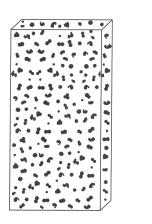Verleningsdossier inspecteren: niet iets wat ingewijden doen
OHIM Board of Appeal 22 maart 2012, zaak R 1482/2009-3 (Termo Organika tegen Austrotherm GmbH)
 Met samenvatting van Laurens Kamp, Simmons & Simmons.
Met samenvatting van Laurens Kamp, Simmons & Simmons.
Gemeenschapsmodellenrecht. Nietigheidsprocedure over Gemeenschapsmodel 150917-0004 voor isolatieblokken. De nietigheidsafdeling oordeelt dat het Gemeenschapsmodel nietig is wegens een gebrek aan eigen karakter. De Derde Kamer van Beroep vernietigt het oordeel, en oordeelt dat het door de verzoeker aangeleverde bewijs bij een normale gang van zaken niet redelijkerwijs ter kennis kon zijn gekomen van ingewijden in de betrokken sector die in de Gemeenschap werkzaam zijn. Het inspecteren van verleningsdossiers is niet iets wat de ingewijden in de betrokken sector normaal gesproken zouden doen.
35 The application for the contested RCD was filed on 10 March 2004 with a priority claim from 11 September 2003. As evidence of an existing earlier design the respondent filed inter alia a copy of the German utility model DE 203 07 608 U1 (D1) for a ‘foamed insulating material’, claiming the priority of a Turkish utility model application TR 2003 00056 (D2), a copy of which was also filed. The German utility model was registered on 28 August 2003 and published on 2 October 2003.
36 The priority date of the contested RCD of 11 September 2003 falls in between the date that D1 was registered and later published. No information has been provided of whether the Turkish utility model application TR 2003 00056 (D2) was ever published. The contested decision found that the files of D1 including a copy of the priority document were available to the public, namely by means of inspection of files at the GPTO, since the date of the registration of D1. This date of registration was prior to the priority date of the contested RCD. In the opinion of the Invalidity Division the presence of a document in a file kept by an IP Office, the file being available to the public by means of inspection of files, is not an event that can reasonably have become known in the normal course of business to the circles specialized in the sector concerned.
37 However, the appellant challenges the admissibility of the publications D1 and D2 on the ground that they had not been made available to the public before the date of priority of the contested RCD because the circumstances under which a design is regarded to be made public is restricted to activities that can be expected in the ordinary course of business. File inspections do not belong to such activities. Inspection of the files with an IP office does not belong to normal routine in the normal course of business to the circles specialized in the sector concerned and therefore the fact that there is a document in a file kept by an IP Office, the file being available to the public by means of inspection of files, is not an event that could reasonably have become known in the normal course of business to the circles specialised in the sector concerned, operating within the European Union.
38 The Board notes first of all that the definitions of prior art in patent law and of a prior design in design law are not the same. Absolute novelty in patent law is farreaching. However, as to designs, the intention of the legislator was to introduce a ‘common sense’ limitation to temper the harshness of absolute novelty, in the form of a ‘safeguard clause’. The ‘safeguard clause’ included in Article 7 CDR states that disclosures which ‘could not reasonably have become known in the normal course of business to the circles specialised in the sector concerned, operating within the Community’ are excluded from the state of the art (see David Musker, Community Design Law, Principles and Practice, London, Sweet & Maxwell 2002, p. 35-36).
43 Therefore, taking into account all of the above, the Board comes to the conclusion that the presence of a document in a file kept by the GPTO, the file being available to the public only by means of inspection of files, cannot reasonably be considered to have become known in the normal course of business to the circles specialised in the sector concerned and therefore, the evidence provided by the respondent cannot be considered to be sufficient to prove the disclosure of a prior design in the meaning of Article 7 CDR.





















































































